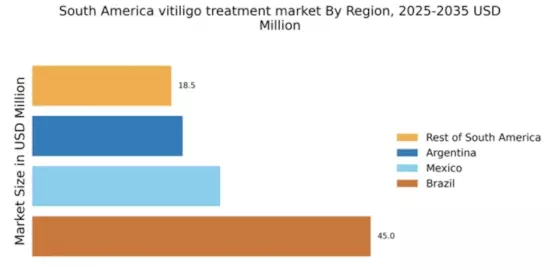Increasing Incidence of Vitiligo
The rising incidence of vitiligo in South America is a crucial driver for the vitiligo treatment market. Recent studies indicate that the prevalence of vitiligo in certain regions may reach up to 2% of the population. This growing number of affected individuals necessitates the development and availability of effective treatment options. As awareness of the condition increases, more patients seek medical advice, thereby driving demand for specialized treatments. The healthcare system in South America is adapting to this need, with an increase in dermatology clinics and specialized centers focusing on vitiligo. This trend is likely to continue, as the population becomes more informed about the condition and its treatment options, further propelling the vitiligo treatment market forward.
Advancements in Treatment Technologies
Technological advancements in treatment modalities are significantly influencing the vitiligo treatment market in South America. Innovations such as laser therapy, phototherapy, and new topical agents are becoming more prevalent. For instance, narrowband UVB phototherapy has shown promising results in repigmentation, leading to increased adoption among healthcare providers. The market is also witnessing the introduction of novel drugs that target the underlying mechanisms of vitiligo, which could enhance treatment efficacy. As these technologies become more accessible, the treatment landscape for vitiligo is expected to evolve, attracting more patients and healthcare professionals to the vitiligo treatment market. This shift may also lead to a competitive environment, encouraging further research and development in the field.
Rising Disposable Income and Healthcare Spending
The increase in disposable income and healthcare spending in South America is a significant driver for the vitiligo treatment market. As individuals have more financial resources, they are more likely to invest in healthcare services, including dermatological treatments. This trend is particularly evident in urban areas, where access to specialized healthcare is improving. According to recent data, healthcare expenditure in South America has been on the rise, with many countries allocating more funds to health services. This increase in spending is expected to benefit the vitiligo treatment market, as patients seek advanced treatment options and are willing to pay for effective solutions.
Growing Support from Non-Governmental Organizations
Non-governmental organizations (NGOs) play a pivotal role in raising awareness and providing support for individuals with vitiligo in South America. These organizations often conduct campaigns to educate the public about the condition, which can lead to increased demand for treatments. By fostering community support and providing resources, NGOs help to destigmatize vitiligo, encouraging individuals to seek treatment. This growing support network is likely to enhance the visibility of the vitiligo treatment market, as more patients become aware of their options. Furthermore, partnerships between NGOs and healthcare providers can facilitate access to treatments, thereby expanding the market reach and improving patient outcomes.
Enhanced Regulatory Frameworks for Treatment Approval
The establishment of enhanced regulatory frameworks for the approval of vitiligo treatments is influencing the market dynamics in South America. Regulatory bodies are increasingly streamlining the approval process for new therapies, which can lead to faster access to innovative treatments for patients. This shift is likely to encourage pharmaceutical companies to invest in research and development for vitiligo therapies, knowing that their products can reach the market more efficiently. As a result, the vitiligo treatment market may experience an influx of new treatment options, benefiting patients and healthcare providers alike. The improved regulatory environment could also foster collaboration between stakeholders, further driving growth in the market.


















Leave a Comment